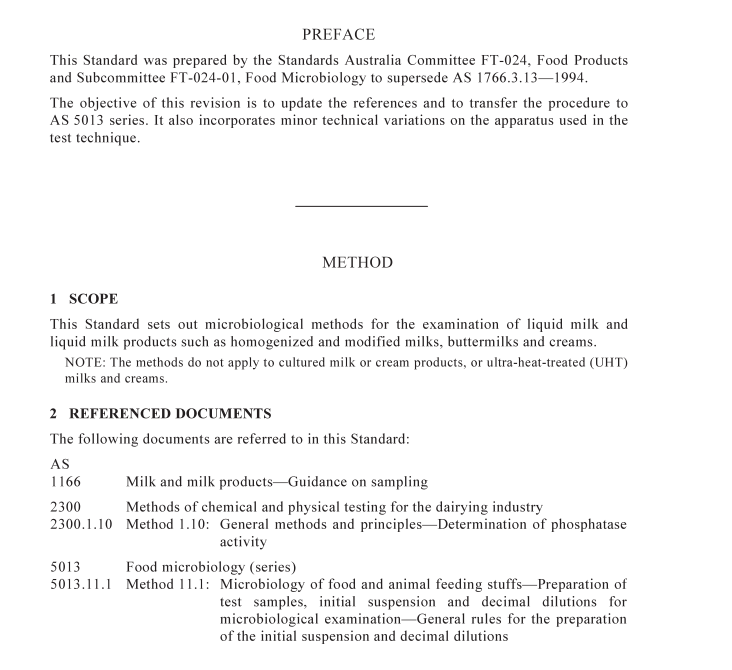AS 5013.28 pdf download – Food microbiology Method 28: Examination of specific products— Liquid milks and creams

AS 5013.28 pdf download – Food microbiology Method 28: Examination of specific products— Liquid milks and creams
3 DILUENTS,CULTURE MEDIA AND REAGENTS3.1 General
The diluents,culture media and reagents specified in this Clause shall be made upaccording to the formulations given in As 5013 series.
3.2 Peptone salt solution
3.3Trisodium citrate dihydrate (NajCH;o(COO)3.2HO) solution 2 %4APPARATUS
The required apparatus is specified in the relevant methods in AS 1166,AS 5013 andAS 2300 referred to in this Standard.
5 SAMPLES
5.1 Laboratory samples
lt is assumed that the laboratory sample has been obtained and delivered to the laboratoryaccording to the procedures set out in AS 1166.
NOTE: The size of the laboratory sample taken in accordance with AS 1166 may be adjusted inorder to provide a sufficient quantity for the required tests.
5.2Storage and laboratory samples
Laboratory samples shall be stored at a temperature not exceeding 4°C, but withoutfreezing, until tested.Testing shall commence within 24 h of sampling.
6PREPARATION OF TEST SAMPLES
NOTE:For samples of pasteurized milk and cream to be prepared for phosphatase testing (seeClause 9), special instructions for preparation and mixing are given in AS 2300.1.10. Theseinstructions should be followed in place of those given below.
6.1 Observation of physical condition and preparation for mixing
Observe the physical condition of the laboratory sample at the time of testing and recordany abnormality.For cream samples only (except for phosphatase testing; see Note above),warm the sample to about 45°C, but not above. Proceed without delay to mixing(Clause 6.2) and the preparation of dilutions. The total time at 45°C shall not exceedi 0 min.
6.2Mixing of sample
6.2.1 Liquid cream.liquid milks and liqusid milk produects
Mix the sample well.lf the first dilution is in a bottle, mix the contents by shaking 25 timesin about 12 s through an arc of 30 cm. If the head space is insufficient for efficient mixing,aseptically pour the contents into a larger container for further mixing.
6.2.2 Thick or coagulated cream
Proceed directly to Clause 6.3.6.3Opening of containersThe procedure shall be as follows:
(a) Thoroughly clean the top of the container,treat with 70% ethanol (w/v) or80% ethanol (viv ) and allow to dry.
(b)Open the closure aseptically, using scissors if necessary.
Completely immerse a screw-capped glass test tube or glass McCartney bottle holding10 mL of sample, in water maintained at 63.5士0.5°C in a thermostatically controlled waterbath fitted with a suitable agitator. The temperature of the sample shall reach 63°C within5 min. After a further 30 min,remove the tube or bottle from the water bath andimmediately cool to 5°C or below in iced water. In placing the container in the coolingwater, avoid wetting the closure but ensure that the level of the water is above the level ofthe milk or cream.Upon removal from the iced water, wipe the tube or bottle with a tissue.8.2 Colony count
Use the pour plate method described in AS 5013,using plate count agar and incubating at30 ±1°C for 72±2 h.
9PHOSPHATASE TEST FOR PASTEURIZED MILK AND CREAM
Carry out the phosphatase test in accordance with AS 2300.1.10,directly on the chilled,undiluted sample.
NOTE:After pasteurization,reactivation of phosphatase in cream can occur. Care shouldtherefore be exercised in the interpretation of results.
10TEST REPORT
The following information shall be reported:
(a)All details necessary for the complete identification of the sample.(b) Reference to this Australian Standard, i.e.AS 5013.28.
(c)Date of testing.
(d)Any abnormality observed in the physical condition of the container or the product.(e)Results of the tests.
(fAny circumstance or conditions that may have influenced the results.









